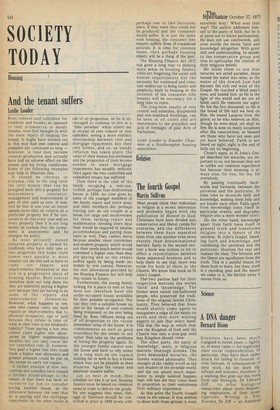Science
A DNA danger
Bernard Dixon
Scientists have been m uch maligned in recent years — rightlY so, in many cases — for neglecting their social responsibilities. In particular, they have been under attack for failing to forestall, or, even forecast, ill consequences 01 their work. All the more nificant and welcome, therefore, Is a warning that goes out this week from one biologist, Dr Edward Ziff, to other biological researchers about some disquieting implications of their investigations. Writing in New Scientist, Dr Ziff — an American
scientist currently based in Cambridge — draws professional and public attention to potentially far-reaching practical dangers arising out of their studies on DNA, the hereditary material found in all living cells. For a research worker to publish such. a Warning is very, very unusual — probably unique. But so too is the nature of the hazard which Dr Ziff discerns behind current research.
The gist of the problem is the Possible emergence, by calculation or accident, of new and harmful types of DNA which, behaving like viruses, could infect laboratory workers and pass into the community. Though formed from existing DNA by hybridisation, such DNA forms would bp novel, and their behaviour uncertain. One clear possibility is that they could be capable of causing cancer.
To understand this development, we must briefly recap the role of DNA in nature. DNA is, of course, the substance that conveys hereditary instructions. It determines whether we have blue eyes or brown, whether plants are tall or dwarf, whether a particular Pneumonia germ is virulent or mild. Such information is carried by DNA in a coded form, just as a message is conveyed via the Morse code. Though we talk generally of .DNA, therefore, we should remember that it takes innumerable different forms. The DNA blueprint for a cabbage clearly differs from that of an elephant or zebra. .
Momentous discoveries of the past twenty years have 'revealed this universality of DNA, combined with its uniqueness, showing how complex information is carried on the 'genetic code'. This has led, logically, to grheat hopes for the as-yet-unborn science of genetic engineering, whose practitioners would repair or replace defective parts of DNA. Certain diseases, for example, which occur when a particular piece of DNA is absent or inactive, could be treated by adding the missing element to the DNA in the cells of the body.
Although practical manoeuvres of this sort are probably several years away at least, the recent breakthrough that worries Dr Ziff is the development of one technique that would be useful for genetic engineering. This is the skill of joining together DNA from very different sources — such as bacteria and viruses. Several viruses responsible for cancer in animals are now known, and one fear is that the linking of the DNA from such a virus with human DNA could allow the hybrid to cause cancer in man. Alternatively, a harmless bacterium as sociated with man could acquire carcihogenic potential in the same way.
Dr Ziff is at pains to point out that these are as yet hypothetical risks. Moreover, the human body has defensive mechanisms for protecting itself against foreign DNA. But these possibilities remain untested. "Until they are,” he writes, "a conscientious scientific community will give especially careful attention to the means of its research as well as its goals, and take the full precautions necessary for ensuring public safety."
Scientists in the United States too have 'issued a public warning about this new research area. Following a top-level meeting (attended by Dr Ziff) earlier this year at New Hampton, New Hampshire, a number of them wrote to Philip Handler, president of the US National Academy of Sciences, outlining the dangers and calling for the setting up of a study committee to consider the problem and recommend practical guidelines. The letter was also published, and has stimulated much discussion — though little practical wisdom.
There's no doubt that the new technique of DNA hybridisation is potentially invaluable to biological warfare researchers. It will obviously facilitate the production of nastier, more virulent microbes. Just as disquieting, however, is the risk of dangerous forms of DNA being fabricated in laboratory experiments conducted with no evil intent whatever. The new knowledge cannot be unlearned, but the initiatives of Dr Ziff and his colleagues give hope that it may be kept under judicious control.



































 Previous page
Previous page